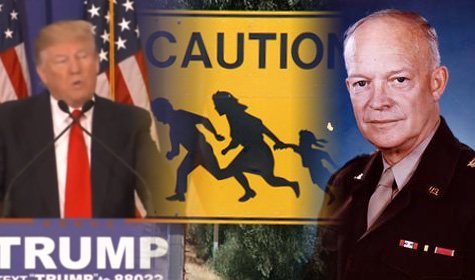Republican frontrunner Donald Trump claims he is going to build a wall along the border and get Mexico to pay for it. This has been laughed off as infeasible, perhaps even a little nutty.
Yet perhaps we should have held back our disdain a little longer. In 1954, President Eisenhower prompted the Mexican government to deploy troops along the border to stop Mexicans from entering the United States. While Mexico didn’t build a wall, they attempted to stem the tide of Mexicans emigrating to the United States and their government paid for it. This might sound great to immigration restrictionists — until they realize how Eisenhower did it.
After months of failed negotiations between the two countries over the terms of the Bracero guest worker visa, the US departments managing the visa issued a press release on January 15, 1954 stating that migrants who entered would be immediately awarded a labor contract and a job.
Outraged by this attempt to cut them out of the negotiations, the Mexican government deployed 5,000 soldiers along the border to threaten, detain, and deter migrants who tried to enter the United States.
Deborah Cohen sums up the resulting chaos:
When the United States actually pulled back the gate and opened the border on January 22, chaos ensued. Hundreds of hopeful migrants rushed past the barrier, aided by the extended arms of United States Border Patrol agents, even as Mexican soldiers charged the men, trying to prevent them from crossing.
Soldiers grabbed their countrymen, often by the shirt, and yanked them back as they were pulled towards the other side by United States border guards. [Mexican] Troops pelted men with fists, guns, water, and clubs in a vain attempt to contain this rush of bodies [emphasis added].
Mexicans who avoided their own military and made it across the border found helpful Border Patrol and INS officers who guided them to labor recruiters who gladly transported them to farms for legal work in the United States.
Negotiations to renew the Bracero program broke down for two main reasons. The first is that the Mexican government sought a monopoly on the export of labor. Article 123 of the Mexican Constitution of 1917 controlled the hiring of Mexican citizens abroad. Cloaked in nationalistic justifications, it was a scheme that created a Mexican government labor monopoly to skim off rents.
To empower Article 123, historian Ernesto Galarza describes a Mexican immigration law passed in 1932 that “authorized the confiscation of vehicles used to transport persons to the border for the purposes of facilitating their illegal entry into the United States.”
Galarza meant “illegal entry” under Mexican law, not US law. Simply put, the Mexican government wanted higher rents and the U.S. government was reluctant to grant them.
The second reason negotiations broke down is that Eisenhower wanted the Mexican government to contribute to migration control by patrolling their side of the border. The Bracero program had existed since 1942 as a bilateral labor agreement between the two countries but unlawful Mexican immigration persisted.
The Mexican government’s failure to control illegal Mexican emigration and never ending American demand for workers lulled them into a position of salutary neglect so that by the early 1950s almost 2 million Mexican unauthorized immigrants were working in the United States. Eisenhower wanted that stopped and thought the Mexicans could help. The Americans eventually solved it themselves.
The negotiations broke down in 1953 and 1954, prompting the Eisenhower administration’s January 1954 announcement that any Mexican who showed up would be granted a work visa. Mexico quickly acceded to American demands and soon Bracero workers were flowing freely back and forth across the border again — to the economic benefit of everybody involved.
Eisenhower’s opening of the border with Mexico in January 1954 was only possible because of the Bracero guest worker visa program that tied the two government’s together. If a future President Trump negotiated a large scale guest worker visa program that allowed many temporary Mexican guest workers in annually and legalized most of the unauthorized immigrants in the United States, he could gain the diplomatic leverage to prompt Mexico to build a wall — or at least deploy some troops in a fancy show.
A legalization and the creation of a large scale guest worker visa program would make such a wall even more irrelevant than it would currently be — unlawful immigration from Mexico has essentially stopped — but at least we’d have a more functional immigration system.
This article originally appeared at Fee.org at: http://fee.org/articles/how-to-get-mexico-to-pay-for-a-wall/

